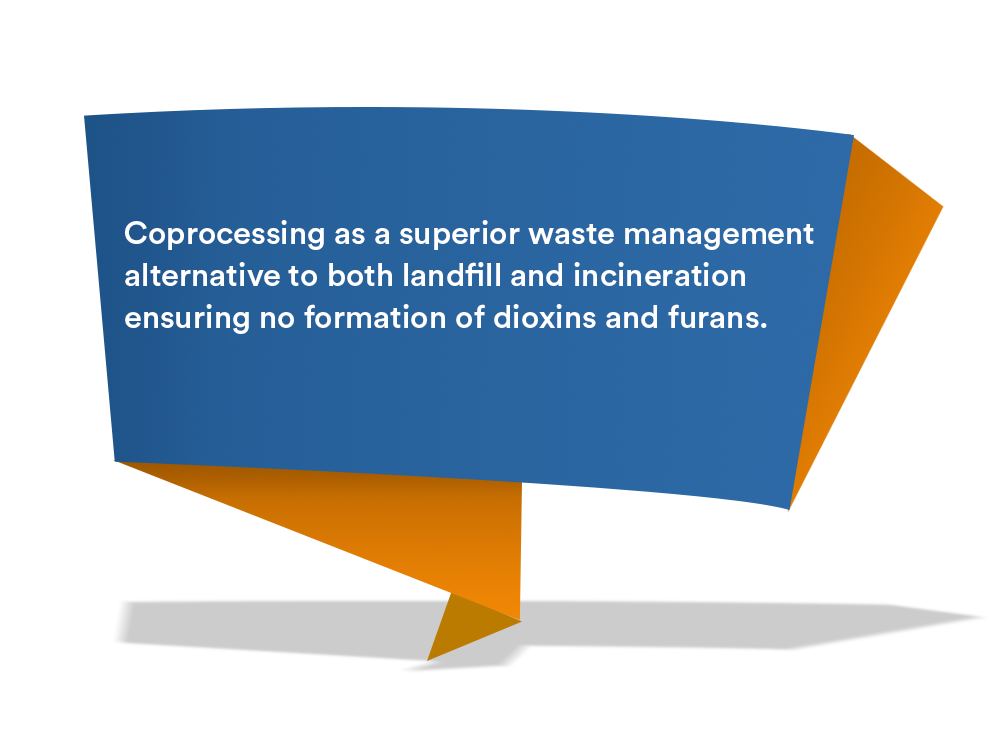India’s ever increasing population, urbanisation and consumerism has made adequate waste management both critical and challenging. The quantum of Municipal Solid Waste(MSW) generated in India is about 62 MT and is expected to increase to 165 MT by 2031 and 436 million tonnes by 2050.1 The rise in waste generation is set to strain the capacity of ULBs to collect, transport, treat and scientifically dispose of solid wastes.
The Cement Industry offers a sustainable solution towards waste management through simultaneous recycling of mineral materials and recovery of energy within one single industrial process of cement manufacturing ie Co-processing. The mineral part of the waste replaces primary mineral materials (such as limestone, clay, or iron) and the combustible part provides the energy needed for the clinker production. Various life cycle assessment(LCA) studies have established coprocessing as a superior waste management alternative to both landfill and incineration. High temperatures, excess oxygen and long residence time within the cement kiln ensure no formation of dioxins and furans. Cement kiln coprocessing technology is accepted by Basel Convention for disposal of hazardous wastes and Montreal Protocol for disposal of Persistent Organic Pollutants (POPs).
Wastes with significant potential to be consumed within the Cement plants include segregated combustible fractions from Municipal Solid Wastes (MSW), non recyclable hazardous & other wastes; plastics wastes; tyre wastes; and biomass. A study conducted by the Confederation of Indian Industry (CII) and Shakti Foundation estimates the contribution of different waste streams in the alternative fuel profile in 2025 . While MSW is expected to contribute to a significant share of alternative fuel utilisation in the Cement Industry, the non homogeneity of the refused derived fuel (RDF) based on MSW is a prominent matter of concern resulting in varied calorific values of the fuel mix.
| Waste Stream | % Share of AF |
|---|---|
| Municipal Solid Waste (MSW) | 57.07 |
| Biomass | 33.97 |
| Tyre Waste | 7.33 |
| Hazardous Waste | 3.46 |
| Spent Pot Lining | 0.81 |
| total | 100% |
Some of the hazardous waste utilised by the Cement Industry include textile Effluent Treatment Plant (ETP) sludge, tannery ETP sludge, Toluene Di Isocyanate (TDI) tar, paint sludge, process waste, chemical sludge, process sludge, phosphate sludge, chemical sludge from ETP,insulation waste, mixed salt, organic residue, liquid organic residue, spent solvent, benzofuran and waste lubricant oil.
Non hazardous waste consumed by the Cement Industry includes agricultural waste, tyre chips, Refused Derived Fuel (RDF), plastic waste, biomass, FMCG expired products and wood chips among others.
CPCB estimates that if a cement plant needs to undertake large scale coprocessing activity, it needs to make investments of more than INR 25-30 Cr/MTPA clinker manufacturing capacity at a thermal substitution rate (TSR) of about 15%.2 Relaxation in import duty of these waste co-processing equipment would help more and more cement plants to implement a system to co-process waste. The prominent aspects to be accomplished before being able to co-process waste are detailed below:
A cement plant needs to install a separate feeding arrangement for undertaking coprocessing of alternative fuels in the calciner or kiln. Feeding Waste that is contaminated with toxic components is fed near the main burner to ensure complete combustion at a higher temperature.
The feeding arrangement is backed up by a covered storage area and a conveying mechanism to transfer the plastic waste from the storage area to the kiln.
A testing lab is required to check the calorific value, ash, moisture, chloride, and other relevant components in the waste. Physical and chemical properties of the waste should be tested including quantum of heavy metals, mineral composition and other parameters, since it has impacts on environment, product quality and operational stability of cement kiln.
Some of the waste is required to be shredded(for complete combustion) to less than 20mm size. In addition, waste is required to free of metallic elements, stones etc to avoid wear and tear of the technological equipment.
About 4% of total energy input of the Indian Cement Industry comes from the use of alternative fuels (AF), which is derived after segregation, treatment and processing of municipal and industrial waste, making it amenable for effective utilisation.3 This share has gradually increased from 0.6% in 2010 and 2.7% in 2017.4 While in percentage terms the AF utilisation is only about 4%, in absolute quantity, India ranks fourth in the world. Cement Companies in India have undertaken individual targets for utilisation of alternative fuels in accordance with the cost effective availability of AFs in the vicinity of its plants.
Optimal utilisation of waste by a cement plant in India is only feasible when the refuse derived fuel (RDF) is a pre-processed combustible material with uniform quality as per the cement kiln specifications. As such, the role of urban local bodies becomes critical in the entire value chain.
India has a significant opportunity to improve its thermal substitution rate (TSR). This, however, is highly dependent on the quantum of production; cost of alternative fuel sourcing and pre-processing; seamless logistics network and active implementation of policy instruments such as the Polluter Pays Principle.
